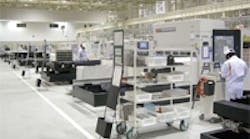Yamazaki Mazak Optonics Corp. opened in February a new manufacturing facility in Minokamo, Japan — near Nagoya — that sets a new level for plant design, layout and cleanliness.
The company’s Phoenix Laboratory has 108,000 sq. ft. of space, and it’s built entirely underground. In fact, it’s 36 ft. (11 m.) below ground.
The plant is dedicated to the production of high-speed, precision laser processing machines, and its underground location provides numerous benefits.
Isolation from the outside environment gives the facility air quality that the company said is 30 times better than typical manufacturing facilities and that air quality is important for the production of the precision optics and components that go into Mazak Optonics’ lasers.
The air for the facility’s general assembly area typically has less than 100,000 dust particles under 0.5 microns per cubic foot, according to Bruce Dozier, senior coordinator for Yamazaki Mazak Trading Corp. Dozier provided a tour of the ninemonth old facility in early November.
Mazak Optonics maintains a clean room that has less than 10,000 dust particles under 0.5 microns per cubic foot for its optical path assembly area, and a cleaner room that has less than 1,000 dust particles under 0.5 microns per cubic foot for its mirror assembly area.
For comparison, Dozier said the typical manufacturing facility has about 3 million dust particles under 0.5 microns per cubic foot of air.
Maintaining such a clean environment is easy in part because the Mazak Optonics facility has one air intake, through which all air entering the plant is filtered. Additional filtering is done for the optical path assembly and the mirror assembly areas.
All of the air in the facility is changed each hour. That means that 1.77 million ft3 (50,000 m3) of air is replaced hourly in the plant.
That is done through a 20-inch air jacket that surrounds the plant. Air is taken in at one corner of the facility and it sweeps through the air jacket that runs the entire length and height of the facility’s external walls. It enters the assembly areas through discreet, filtered vents, and it is removed through other vents for a positive air flow toward the outside.
Besides that, the underground location allows the facility to take advantage of the geothermic energy to reduce costs and pollution.
The underground ambient temperature typically is about 61 degrees F. (16 degrees C.) and that, combined with the building’s air jacket maintains an even internal temperature for the facility. Dozier said the building has an auxiliary heating and air conditioning unit, but that the HVAC unit it is one-fifth the size that a similar, above-ground facility requires.
Here are the benefits Dozier noted from the underground location:
Mazak Optonics has, essentially, a clean room environment for the assembly of every part of its laser cutting machines. That helps to make the machines free of contaminants of every sort, and lends to their precision. Mazak Optonics also notes that it saves money in producing its machines because time and effort to clean machines after assembly now is not required.
The stable temperature in all parts of the manufacturing area contributes to the precision of the laser machines. The company never has to worry about fluctuating temperatures that could affect the fit and function of its machines.
External vibration — from sources such as automotive and truck traffic — is eliminated. In fact, for its location, having the facility underground provides a buffer against vibration and shaking even from earthquakes. The company further isolates vibration and dirt from the facility by not allowing any trucks to enter it. All shipping and receiving is done by overhead cranes that receive and deliver product to a specially designed receiving dock.
Operating costs are minimized by the combination of the stabilizing effect of geothermal energy that is used for heating and cooling, and the company’s ability to control and filter air in the plant.
In land-starved Japan, the company is able to claim that it uses nearly 100 percent of the land it owns and set aside for the facility, and grass and trees grow on the land atop the factory.
And, the factory is environmentally friendly — for both its maximized land use and its minimized energy requirements. That fact caught the attention of one of Japan’s interior ministries.
Mazak Optonics has about 220 employees who make the company’s comprehensive line of laser cutting machines at the facility.
It requires an elevator ride to enter the facility, and visitors are required to wear clean-room gear.
Mazak Optonics produces 2D and 3D laser machines that are used to cut and bevel sheet metal, tubes, pipes, channels, beams and other structural components from a variety of metals.
The company’s CNC laser machines do automated parts programming, nesting, loading, unloading, scrap removal, and parts stacking and sorting. Its products include automation equipment, its own computer-numerical controllers, and software.
Mazak Optonics produces its own linear motors and mirrors that it requires for its laser cutting machines.







